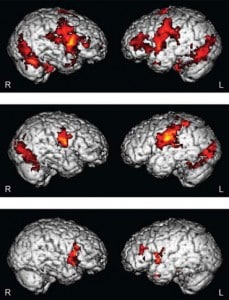
The study, which was published in Proceedings of the National Academy of Sciences, looked at 62 children between the ages of 4 and 17. The children were divided into three groups; those with autism spectrum disorders, their unaffected siblings, and children who were not autistic and did not have affected siblings.
Children with autism spectrum disorders have difficulty understanding “biological motion,” that is, they have a hard time interpreting peoples movements. So, the researchers used functional magnetic resonance imaging (fMRI) to observe the children’s brain activities while they watched a series of animations of biological movement.
They discovered that the three groups of children produced three distinct “neural signatures.” The autistic children had reduced activity in certain areas of the brain. Their unaffected siblings exhibited the same inactivity, but were able to compensate with enhanced activity in other parts of the brain. There were also areas of the brain that only exhibited reduced activity in the autistic subjects.
Martha Kaiser, predoctoral associate at the Yale Child Study Center, is hopeful, “This study may contribute to a better understanding of the brain basis of ASD, and the genetic and molecular origin of the disorder.”
It is hoped, that with additional research, it will be possible to diagnose autism earlier and more accurately. – Jen R, Staff Writer
Related Articles:
- Study Finds: Autism Risk Gene Rewires the Brain
- Vaccine and Medication Safety are Parents’ Top Research Priorities
- If A Simple Test Could Save So Many Babies. Why Isn’t It Mandatory?
PHOTO (fMRI of an autistic child VIA Dana.org)






